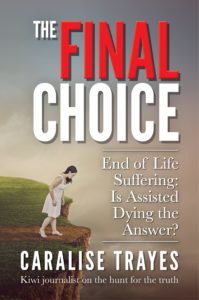THE FINAL CHOICE — End of life suffering: Is assisted dying the answer?, by Caralise Trayes (Capture & Tell Media, 2020) 276pp, $29.99. Reviewed by PAT McCARTHY.
 What happens when an enquiring Kiwi journalist seeks the truth about the End of Life Choice Act that the country will vote on in this year’s general election?
What happens when an enquiring Kiwi journalist seeks the truth about the End of Life Choice Act that the country will vote on in this year’s general election?
Caralise Trayes goes about the task by interviewing key people on both sides of the issue — including David Seymour, who wrote the Act, and John Kleinsman of the Catholic Nathaniel Centre — and looking at experiences in countries where assisted dying is already legalised.
She deals with the case of assisted dying advocate Lucretia Seales, who gave a strong emotional thrust to the passage of the Act, and reports her mother, Shirley Seales, as telling an End-of-Life-Choice Society meeting that Lucretia would not have chosen to use assisted dying “but having the choice would have brought comfort”.
The author contrasts Lucretia’s case with that of the lesser-known Vicki Walsh, who was diagnosed around the same time with the same brain cancer and considered suicide while in a state of depression. After defying her doctors’ prognosis of 12-14 months by living on for nine years, she says “it’s not about dying with dignity; it’s about living with dignity”.
Trayes says she soon came to the conclusion that the common voice in favour of the End of Life Choice Act was “endearingly simplistic”. Interestingly, she found that religion did not determine which side someone sat on; in fact, it was seldom relevant to anyone’s reasoning. As an ethicist said, “This is not a religious issue, but a societal issue”.
Contrary to the impression that assisted dying has become an irresistible international trend, the author notes that many more jurisdictions have rejected assisted dying laws than have accepted them.
Her overseas research, covering the Netherlands, Belgium, Canada and the United States, reveals many abuses of assisted dying laws — but she observes that no doctor has ever been found guilty of improper practice.
In support of the “slippery slope” argument, she learns of a proposal in the Netherlands for assisted suicide to be extended to those of any age who consider “their lives have been completed”.
Trayes summarises the New Zealand Act’s provisions, pointing out that these have been misunderstood by many who took part in public opinion polls.
Some takeaways are the flimsy nature of the Act’s “safeguards”, the lack of basic monitoring of its operation, the guesswork involved in doctors’ prognoses, the emptiness of the “choice” argument when only one choice is being offered, the likely corrosive effect on doctor-patient relationships, public confusion about what is already legal (such as refusing to be resuscitated), and the general Kiwi unease at talking about death and disability.
This book is as up-to-date as Covid-19 (several of the interviews were conducted by Skype during lockdown).
There has to be a better way, the author concludes. She suggests: Improve and expand palliative care, demystify death through education, be a friend to those who are terminally ill, write an advance directive for use in the event of serious illness, and “be a hope-maker”.
The author’s compassionate approach and conversational style, even when asking hard questions, make this a very accessible book. Anyone uncertain about how to vote in September should read it.
- Pat McCarthy was the founding editor of the pro-life newspaper Humanity.
Thanks for this very useful review that sums up Trayes’ evidence on the many reasons to oppose this act.